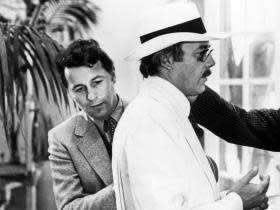Robert Frank: Photographer whose studies of ordinary America were hugely influential

“That crazy feeling in America when the sun is hot on the streets and the music comes out of the jukebox or from a nearby funeral, that’s what Robert Frank has captured in tremendous photographs when he travelled on the road around practically 48 states in an old used car and with the agility, mystery, genius, sadness and strange secrecy of a shadow photographed scenes that have never been seen before on film.”
Jack Kerouac’s introduction to Robert Frank’s 1958 book The Americans encapsulated the excitement that many felt when they first saw this collection of black-and-white documentary photographs. By no means a lavish publication, it nevertheless became one of photography’s cult books, inspiring generations of photographers to document the intriguing nuances of the everyday.
Frank, who has died aged 94, trained as a photographer in Switzerland in the early 1940s, working on stills for film productions during the war years before turning freelance in 1945. He sailed for New York in 1947, finding work at fashion journals Harper’s Bazaar and Junior Bazaar. But the world of fashion was not to his liking – he disliked the image’s subservience to the story and the dominance of art directors and editors – and soon he was freelancing in a city that was at the centre of the new documentary photography movement.
In his early New York photographs he began chronicling city life, producing a series that in time would convince generations of photographers and curators of the value and depth of subjective documentary. A Guggenheim fellowship in 1954 allowed him to begin an odyssey across the US, making the photographs that Kerouac would describe as “a sad poem sucked right out of America”.
The Americans consisted of 175 black-and-white photographs. None were dramatic, all were of ordinary scenes: a man and a woman glimpsed through a car window in Detroit; a waitress in a coffee shop in Indianapolis; a young woman in furs at a movie premiere in Hollywood. In search of subjects, Frank travelled all over the country, waiting to chance upon an ordinary moment redolent with mystery and meaning. The Americans is pervaded by a sense of melancholy and disconnection, a nostalgia for a disappearing society melded with a powerful appreciation of modernity – or, as the critic Mikael van Reis put it, “a country of vacant skies, long roads and hungry hearts”.
Read more
Piero Tosi: Costume designer who lit up Italian postwar cinema
The Americans was published first in France in 1958, then in the US the following year. Frank had met Jack Kerouac and the Beat poets in New York, and he asked the On the Road author to pen the book’s introductory essay. Like Frank, Kerouac was fascinated by America’s vastness, by its diverse populations and its underlying sense of unease, and his essay was an apt companion for the photographs.

In time Frank was diverted from photography into filmmaking and quickly become absorbed in a medium that depended less on the whims of art directors and more on individual entrepreneurism. After his film debut Pull My Daisy (1959) – co-directed by Alfred Leslie, written and narrated by Kerouac and featuring Allen Ginsberg and others from the Beat movement – he joined with a group of US filmmakers to form the New American Cinema Group. His film output included Conversations in Vermont (1969), About Me: A Musical (1971) and, most famously, the Rolling Stones documentary Cocksucker Blues (1972). He also taught film in Rochester and later Halifax, Nova Scotia (he had moved to Canada in 1971).

His photographic style shifted during this time, influenced by cinematography and a kind of poetic improvisation. His work graced the cover of the Stones album Exile on Main St (1972), and that year saw the publication of his second photography book, The Lines of My Hand. These images were more radical, with texts scrawled on the surface of the print, photos arranged as assemblages, coded messages decipherable only by a cognoscenti. The death of his daughter in an air crash in 1974 appeared to prompt more of a dissonant rage in his work.

He continued to make films such as Life Dances On (1980) and Home Improvements (1985), but it is his photography that has endured and thrived in reputation. The subject of a 2015 documentary film Don’t Blink – Robert Frank, he was a maverick in his field, with an incisiveness of vision and an understanding of the violence and melancholy of everyday life – no easy thing to quantify.
He is survived by his second wife, June Leaf, and a son. A daughter predeceased him.
Robert Frank, photographer, born 9 November 1924, died 9 September 2019
Val Williams is professor of the history and culture of photography at the London College of Communication, part of the University of the Arts London
Read more
Read more Piero Tosi: Costume designer who lit up Italian postwar cinema

 Yahoo News
Yahoo News 

